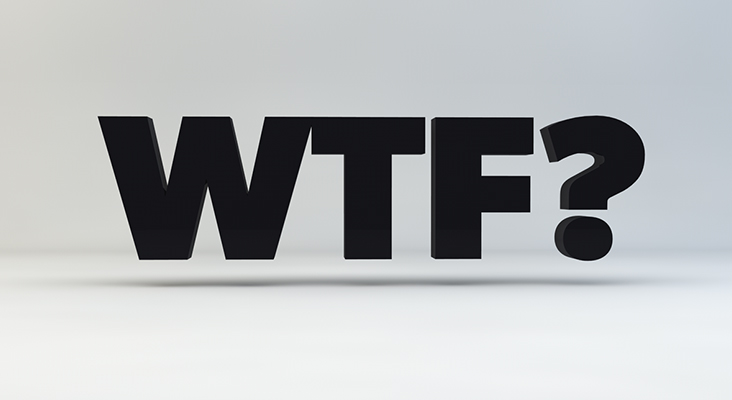Save 50% on a 3-month Digiday+ membership. Ends Dec 5.

This article is a WTF explainer, in which we break down media and marketing’s most confusing terms. More from the series →
Software is eating the world, including the media industry. The rise of ad tech has meant an alphabet soup of acronyms and bizarre new terms. Digiday is breaking it all down in plain English as part of our WTF ad tech series. See other entries here. This installment focuses on programmatic guaranteed ad buying.
Someone just told me 2015 is going to be The Year of Programmatic Direct. I readily agreed. WTF did I agree to?
Programmatic direct is a way to automate direct ad buys for set campaigns.
OK, but is that any different than programmatic guaranteed?
No, not really. You could say programmatic direct encompasses both guaranteed and non-guaranteed contracts.
What about programmatic premium?
Same thing, depending on who is speaking.
And programmatic reserved?
This is awkward, but it’s the same.
That’s so confusing.
Yes, this is ad tech.
So this is different than real-time bidding?
Yes, it is. Guaranteed ad buys don’t involve an auction. Think of it like Wall Street. The spot markets involve real-time bidding, but the majority of trading takes place with guaranteed buys. That’s what’s going on here.
Ad position: web_incontent_pos1
Ah, RTB is about the remnant, low-quality ad space and programmatic direct is about the high-quality stuff?
Not really. They’re just different ways of buying ad space. “Premium is in the eye of the beholder,” said Joe Pych, CEO of NextMark, an ad buying tech provider.
OK, this is for the majority of ad buying?
Yes, most ad buying is not done in an auction like RTB. The thought behind programmatic direct is to take the automation mechanisms that were popularized by RTB and apply them to the typical ad buying process.
It’s the same technology?
Some think it should be, others think RTB tech isn’t right for a market with completely different dynamics. Needless to say, the opinions are often colored by what their companies do.
What’s the advantage of doing that?
Ad buying is horribly inefficient. One estimate is that $10,000 of overhead goes into the standard ad buy. As they say in tech, that doesn’t scale.
Ah, it’s replacing salespeople.
Maybe. It might replace ad operations people more. Ad buys in digital are more than buyer and seller. They involve ad ops to make sure the campaign actually runs. There are clear efficiencies that can be gained in taking a lot of the back-and-forth headaches out of the process.
Ad position: web_incontent_pos2
This must be huge.
No. Programmatic direct is a tiny sliver of the programmatic market, which is still a small part of the digital ad market, which is … you get the point. Still, a lot of people see potential in it. “There’s a north star,” said Pych. “But you’d think we’re closer than we are.”
Is this something media agencies will do? Or trading desks?
Either.
Is this different from private exchanges?
It is. The private marketplace gives more power to the ad buyer to choose whether it wants the inventory.
Sounds like more of a feature than a product.
Bingo. Well, that’s not fair, it could turn out that way. Jeremy Hlavacek, vp of programmatic at The Weather Company, sees it this way: “It requires the rethinking of a lot of ad tech infrastructure. If we use more automation, we’re saying [ad serving] needs to be rethought.”
Who is pushing this?
There are specialized vendors like iSocket, NextMark, Shiny Ads and Adslot. Google has this option. Rubicon and other existing yield management platforms offer this.
Are big publishers adopting this?
Yes. Yahoo announced it would open up inventory through this method. Other major publishers are dabbling in it.
What’s the holdup?
Oddly enough, the sellers are ahead of the buyers here. Too few buying systems are able to send orders to programmatic guaranteed provider systems. Plus, the influx of automation is roiling all sides of the media buying system. For instance, media agencies and trading desks are set up to fight over programmatic direct budgets. For publishers, using automation in this way requires retraining sales teams and possibly reorganizing ad ops. And then there’s Google and other major platforms that have their own agendas.
Where can I learn more?
Check out the Interactive Advertising Bureau’s overview of programmatic. It likes to call this “automated guaranteed.”
Wait, another term?
Yes, this is ad tech.
Download Digiday’s complete WTF Programmatic guide, including 11 explainers detailing the ins and outs of programmatic advertising.
More in Media

What publishers are wishing for this holiday season: End AI scraping and determine AI-powered audience value
Publishers want a fair, structured, regulated AI environment and they also want to define what the next decade of audience metrics looks like.

Digiday+ Research Subscription Index 2025: Subscription strategies from Bloomberg, The New York Times, Vox and others
Digiday’s third annual Subscription Index examines and measures publishers’ subscription strategies to identify common approaches and key tactics among Bloomberg, The New York Times, Vox and others.

From lawsuits to lobbying: How publishers are fighting AI
We may be closing out 2025, but publishers aren’t retreating from the battle of AI search — some are escalating it, and they expect the fight to stretch deep into 2026.
Ad position: web_bfu